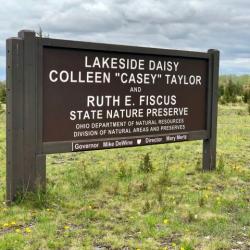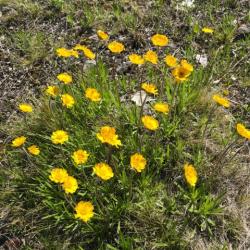Part of our Time Traveler Series
 On the side of a small lane in Marblehead, Ohio lies a rocky plain of former quarry land, that each May turns to a carpet of gold. The creator of this yellow glow is the Lakeside Daisy (Tetraneuris herbacea), an endangered plant that grows on ground one would think uninhabitable to most flora. Once native to much of the Great Lakes region, it now occurs only in Ohio, Michigan, Illinois, and Ontario in small patches. In our region, the main area is the aforementioned spot in Marblehead called the Colleen Taylor and Ruth Fiscus Lakeside Daisy State Nature Preserve. This 136-acre preserve lies entirely on former quarried land on the peninsula. The plant was so rare when it was listed as endangered, that its only natural population known at the time was these areas in Marblehead.
On the side of a small lane in Marblehead, Ohio lies a rocky plain of former quarry land, that each May turns to a carpet of gold. The creator of this yellow glow is the Lakeside Daisy (Tetraneuris herbacea), an endangered plant that grows on ground one would think uninhabitable to most flora. Once native to much of the Great Lakes region, it now occurs only in Ohio, Michigan, Illinois, and Ontario in small patches. In our region, the main area is the aforementioned spot in Marblehead called the Colleen Taylor and Ruth Fiscus Lakeside Daisy State Nature Preserve. This 136-acre preserve lies entirely on former quarried land on the peninsula. The plant was so rare when it was listed as endangered, that its only natural population known at the time was these areas in Marblehead.
This very unique plant grows on areas referred to as alvars, which is a type of limestone “pavement” where little else may grow. The Nature Conservancy stated, “alvar habitat consists of flat limestone or dolostone bedrock with thin to no soil, few to no trees, and is subject to seasonal drought.” The plant is capable of growing in soil, but is it often quickly displaced by other, more aggressive plants.
 The plant itself has double notched yellow flowers and long, narrow leaves which radiate from a center basal rosette. Young plants can be differentiated from more mature specimens by their fuzzy leaves. As plants age, the fuzzy hairs will disappear and older plants are nearly hairless. First year plants often produce only one rosette and, as the plants age, they increase their number of flowers. These flowers in spring are produced on stalks 6-10 inches tall. Several species of insects help pollinate the plants, including bumblebees, small carpenter bees, and halictid bees, as well as some species of flies and butterflies. A much smaller number of plants will occasionally produce shorter flowers in the fall.
The plant itself has double notched yellow flowers and long, narrow leaves which radiate from a center basal rosette. Young plants can be differentiated from more mature specimens by their fuzzy leaves. As plants age, the fuzzy hairs will disappear and older plants are nearly hairless. First year plants often produce only one rosette and, as the plants age, they increase their number of flowers. These flowers in spring are produced on stalks 6-10 inches tall. Several species of insects help pollinate the plants, including bumblebees, small carpenter bees, and halictid bees, as well as some species of flies and butterflies. A much smaller number of plants will occasionally produce shorter flowers in the fall.
These beautiful flowers have some other interesting qualities. The flowers open almost all at once, allowing pollination to more easily occur. This is important because the flower cannot reproduce with other plants that are genetically too closely related to them. In addition to flowering en masse, the flowerheads themselves actually move throughout the day, following the sun (a phenomenon called heliotropism or sun tracking).
 The largest naturally occurring population is still the previously mentioned preserve and the surrounding quarry land. Because of its reliance on these limestone plains, habitat loss has been one of the prominent reasons for its endangerment. Limestone is used in many forms and has been quarried in the Marblehead area since at least the early 19th century. In fact, there is still an active quarry on the Marblehead Peninsula, currently run by Lafarge North America, but many quarrying activities have preceded Lafarge in quarrying lime and limestone for various purposes throughout the last several hundred years. Early quarrying, which was much less technologically advanced, did less to disturb the habitat as the process was much slower. Over the years as the quarry (and types of quarrying activities) grew, the amount of viable habitat for the Lakeside Daisy was severely diminished. Not only in Marblehead, but in many other alvar ecosystems throughout the Great Lakes. Kelleys Island, historically home to its own quarry, ran into the same issues, destroying nearly all of the native daisies. Fortunately a new population has been started in the East Quarry trail area on the island. The beautiful daisies are also now viewable from a new overlook at the recently re-vamped Glacial Grooves Geological Preserve. Several other populations have also been repatriated in the Lakeside-Marblehead area, as well as the populations in Michigan, Illinois, and Ontario.
The largest naturally occurring population is still the previously mentioned preserve and the surrounding quarry land. Because of its reliance on these limestone plains, habitat loss has been one of the prominent reasons for its endangerment. Limestone is used in many forms and has been quarried in the Marblehead area since at least the early 19th century. In fact, there is still an active quarry on the Marblehead Peninsula, currently run by Lafarge North America, but many quarrying activities have preceded Lafarge in quarrying lime and limestone for various purposes throughout the last several hundred years. Early quarrying, which was much less technologically advanced, did less to disturb the habitat as the process was much slower. Over the years as the quarry (and types of quarrying activities) grew, the amount of viable habitat for the Lakeside Daisy was severely diminished. Not only in Marblehead, but in many other alvar ecosystems throughout the Great Lakes. Kelleys Island, historically home to its own quarry, ran into the same issues, destroying nearly all of the native daisies. Fortunately a new population has been started in the East Quarry trail area on the island. The beautiful daisies are also now viewable from a new overlook at the recently re-vamped Glacial Grooves Geological Preserve. Several other populations have also been repatriated in the Lakeside-Marblehead area, as well as the populations in Michigan, Illinois, and Ontario.
 Not much recognition was given to this small but mighty flower until the work of two women, to whom I’m sure this little daisy will be forever grateful. Colleen Taylor and Ruth Fiscus made it their mission to make sure this flower did not disappear forever. Through their efforts, in 1988, a 19-acre portion of the current preserve was established. Over the years, this has grown to its current 136-acres.
Not much recognition was given to this small but mighty flower until the work of two women, to whom I’m sure this little daisy will be forever grateful. Colleen Taylor and Ruth Fiscus made it their mission to make sure this flower did not disappear forever. Through their efforts, in 1988, a 19-acre portion of the current preserve was established. Over the years, this has grown to its current 136-acres.
If you are in the area in the early to middle part of May it is almost a MUST to stop and see this beautiful and unique flower! The Colleen Taylor and Ruth Fiscus Lakeside Daisy State Nature Preserve is open daily dawn-dusk and can be found at 309 Alexander Pike in Marblehead.
I look,
Not always to the lotus
But often to the Lakeside Daisy.
A rare thing, almost unknown,
Growing not in the soft mud,
But in hard calciferous stone.
Its tiny foliage pointing
Like small swards,
Thrusting up its brief bloom,
Shining,
Not a finch or canary yellow
But a brilliant hue all its own.
My heart is overjoyed, briefly,
Just knowing such beauty can
come from stones
Yet it makes me long
To bloom like this,
From the hard places
Yet covered.
Not a finch or canary yellow
But a brilliant hue all my own.
-B. Shifflet



